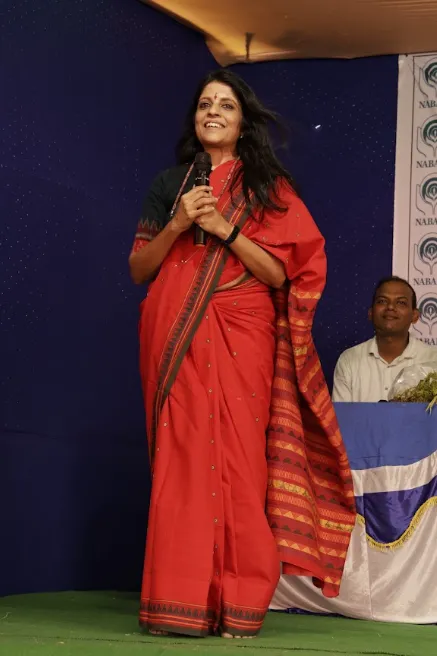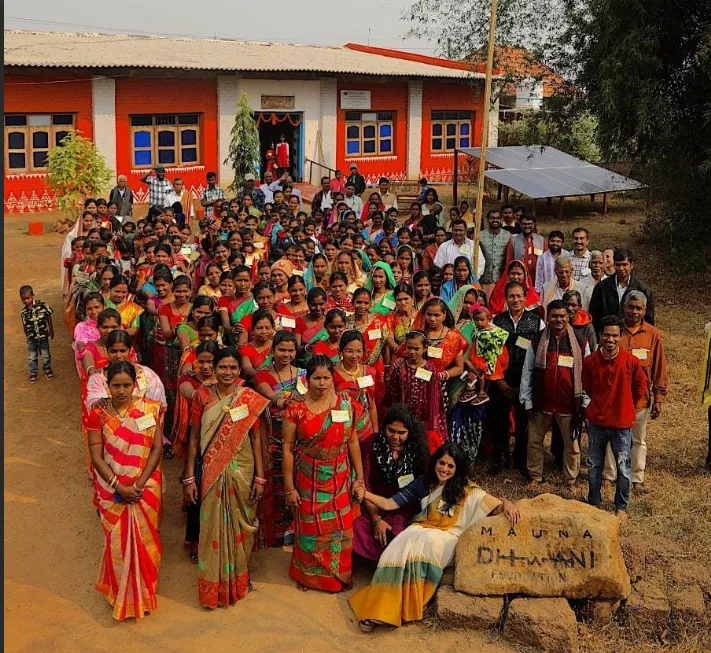Meet the woman weaving hope in Odisha’s forgotten villages
After 22 years in the corporate world, Bindu Vinodhan left her career to help revive a lost weaving tradition in a remote village in Odisha, empowering 800 women through the Mauna Dhwani Foundation.
In 2016, Bindu Vinodhan stood on stage at Disney World, Florida, to receive a global award for her contributions to organisational development. It was a moment of pride, a highlight of her 22-year career and a symbol of success. She should have been on top of the world; instead, she felt a sense of emptiness.
“I blanked out completely,” she recalls, niggling doubts overriding her achievement. “Is this it? Is this what I’ve been working towards?”

Bindu Vinodhan - founder of Mauna Dhwani
An engineer with a Master’s degree from Oxford University, Vinodhan grew up in Mumbai, raised by parents who were always welcoming to those in need. She followed the conventional corporate path until that wake up call in Florida.
Two months later, Vinodhan resigned from a job that could have put her on track to becoming a CXO, and walked away from a successful career to venture into the unknown.
Initially, there was no concrete plan—just a strong determination to do something meaningful. This led her on a journey to the hinterlands of Odisha, where she would transform the lives of hundreds of marginalised women, revive a forgotten art form, and challenge societal norms with Mauna Dhwani.
Before starting her own venture, Vinodhan volunteered with Swasti, a Bengaluru-based NGO that rehabilitates women in sex work. It was here she realised that she wanted to work in the field of gender, and started her own NGO Mauna Dhwani in 2017.
“Mauna means silence and Dhwani is sound—and the movement from silence to sound is important, especially for women because a lot of times, the voices inside us are never ours,” she elaborates.
An interaction with activist-politician Annie Raja led her to a realisation–the root of the problem lay much deeper. Women in sex work often came from vulnerable communities where generational poverty and exploitation pushed women and children into trafficking, bonded labour, or even worse circumstances.
Vinodhan set out to investigate. But the questions were overwhelming–where to begin and how to go about it. In 2018, a simple Google Search led her to Chuliaposhi, a village in Mayurbhanj, northern Odisha, right at the bottom of India’s BPL (Below Poverty Line) index. The village had no schools, healthcare, water, roads, or electricity.
The village that had no future
When Vinodhan first visited the village, she noticed that it was eerily quiet.
“There were few young people there–they had either migrated for work, become alcoholics, or died by suicide under the burden of debt,” she says.
The women left behind worked as bonded labourers in the fields of upper-caste landlords, earning barely enough to eat once a day. Children weren’t sent to school until they were old enough to walk 8 kilometers each way.
And the scariest reality? Many of these children were disappearing—trafficked into cities. The younger women were at constant risk of being trafficked as domestic workers or sex workers.
It was a place where no one spoke of tomorrow, let alone dreams.
As she spent more time in the village, she realised that it was home to artisans skilled in the Mayurbhanj Santali weave—a craft that had been lost over 80 years ago.
It was crucial for her to learn the local language, be patient and constantly reassure them that she was not a threat.
She reached out to local NGOs, hoping to collaborate, but no one responded.
“I was an outsider, a woman from Bengaluru, corporate-trained and city-bred. No one took me seriously.”
But one young social worker, Gobind Dalai, was curious. He helped her meet the community, became a strong pillar of support, and later, was appointed a member of the board.
The first year was brutal. They saw her as a threat. The police, deeply entrenched in the local power structure, were not on her side.
She was harassed. Her car was vandalised.
“I was taken to the police station, questioned, suspected of being a Maoist. I had never seen a police station before,” she says.
Her team was also physically attacked. “One day, a group of men came with rods and sticks, trying to chase us out. It was terrifying,” she recalls.
By the end of the first year, exhausted and defeated, she was ready to leave.
That was when Raghumasa, the oldest man in the village, knocked on her car window.
"Jhiya (daughter in Odiya),” he said, “you will come back, right?”
Eight young women stood behind him, repeating his words.
“They could see it in my face. They knew I was about to leave. And at that moment, I knew I had to stay,” she says.
Rediscovering a lost legacy

A woman working on a loom
To fulfill her promise to herself and to the women who believed in her, Vinodhan asked them what they wanted. Their traditional Mayurbhanj Santali weave had disappeared over 80 years ago, and only one old man still remembered it.
“When I asked the women what they wanted, they didn’t say food, money, or jobs. They said, “Give us our craft back”.”
Vinodhan spent two years in ethnographic research, visiting museums, and collecting forgotten records. She worked with textile historians and the Delhi Crafts Council to piece together the lost craft.
One challenge loomed large before her–while women did most of the weaving work, only the men were credited for it.
“In Odisha, women do 60% of the weaving work, but only men sit on the loom. Only men are called artisans.”
Vinodhan refused to accept that.
She started with eight women in a livestock shed donated by one of the villagers—goats on one side, and looms on the other. Then the team built the first toilet in the village, offering women privacy for the first time. She also gave them a stipend to support their work.
The transformation wasn’t just economic—it was social.
One evening, two drunk men stormed into the weaving centre, as they had done in the past, intending to harass the women.
But this time was different.
"For the first time, the women took out their brooms and slippers and said, ‘No more, and chased them out’,” recounts Vinodhan.
The women had found their voices.
Master trainers from other parts of Odisha came to teach the women, but to Vinodhan’s astonishment and dismay, they just couldn’t weave. They were malnourished and lacked the strength to operate the looms. So, she started a community kitchen, Naivedya, to cook food for 500-600 women and their families.
This was followed by the opening of a school. It was mandatory–all artisans who worked with Mauna Dhwani had to send their children to school.
It became a ripple social effect–one that would lead to 800 women artisans becoming part of their initiative, reviving a lost heritage, securing a future for themselves and their families. Today, Mauna Dhwani has 21 centres with each centre catering to 2-3 villages.
Taking the Mayurbhanj Santali saree to the world

800 women artisans are part of Mauna Dhwani's initiative, reviving a lost heritage, securing a future for themselves and their families. Today, Mauna Dhwani has 21 centres with each centre catering to 2-3 villages.
Mauna Dhwani started by creating items for corporate gifting—eco-friendly bags, diaries, and accessories. Large companies prefer them because they help reduce plastic waste and earn carbon credits.
One of its biggest partners is a shipping company that replaced all its plastic packaging with handwoven jute and cotton bags. Vinodhan says this partnership alone sustains a steady monthly income for many of the artisans.
She is also focussing on giving the Mayurbhanj Santali saree a new lease of life.
"The Mayurbhanj Santali saree was lost for nearly a century. It is distinct from other Odisha weaves because it incorporates tribal geometric patterns with advanced weaving techniques. We spent two years doing ethnographic research, visiting museums, and working with textile historians to revive it. We presented our findings to the Delhi Crafts Council, and they are now supporting us."
"Originally, this saree came only in white and red. But we are now creating variations, incorporating colours so that people can wear different versions while staying true to the original craft,” she adds.
Now, for the first time, the Mayurbhanj Santali Sari Collection will be showcased at Kairi Summer Textile Exhibition in Delhi. Following this, they will apply for a Geographical Indication (GI) tag to officially recognise the weave as part of Odisha’s textile heritage.
Apart from sarees, the women work on home textiles—linen, table runners, cushion covers, and embroidered fabrics—so that the craft reaches a wider audience. The sarees and other products will be sold under the brand name, Kukmu that translates into “manifestation of dreams” in Santali.
“We refuse to sell on sympathy,” Bindu says. “People should buy our products because they are stunning, not because they feel sorry for us.”
Next, they plan to grow their own cotton, set up small spinning centres, and bring back indigenous cotton farming.
The cost of building this movement has been deeply personal for Vinodhan. She sold everything she owned—her Mumbai flat and the land her father left her to fund the project. She still works two weeks a month as a consultant to fund her team’s salaries.
Her dream? That one day, she won’t be needed.
“The real success will be when they run it on their own. That’s when I’ll know we have won.”
(The story has been updated to add details on Gobind Dalai and the Delhi Crafts Council.)
Edited by Megha Reddy







